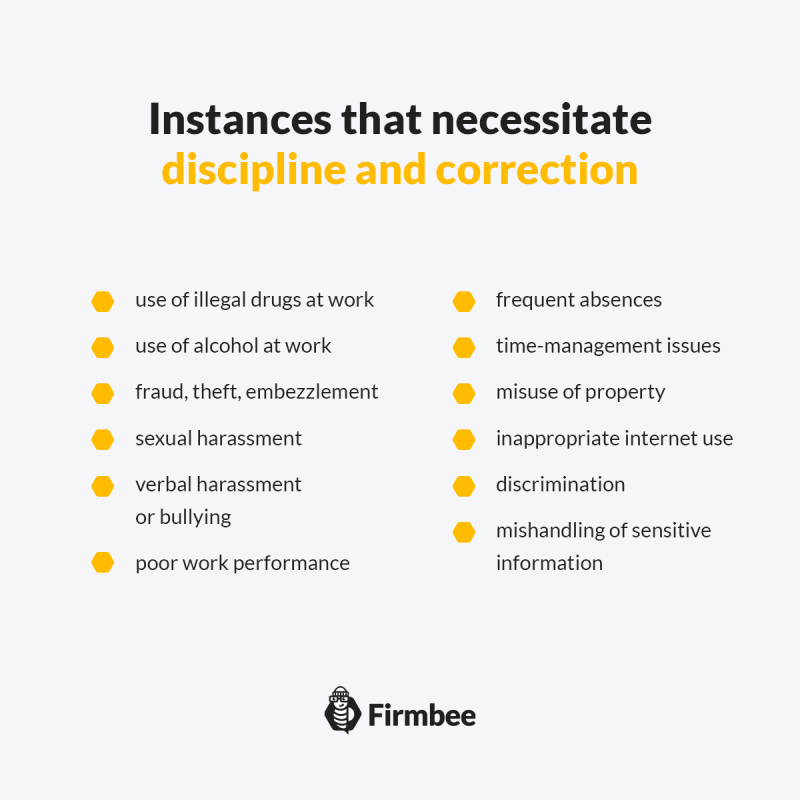How to discipline employees? What are the most effective tactics to correct employee’s performance? Do you know how to write your own employee handbook? Read the article below to know the answer to these questions.
How to discipline employees? – table of content:
- How to discipline employees?
- Write your own employee handbook
- Work with your managers
- How to discipline employees – 4 steps of disciplining
- Summary
How to discipline employees?
The discipline starts with clear and concise communication. Every employee has to know what is expected from them. Employers have to introduce their own conduct policies to maintain order at a workplace because the legal regulations do not regulate all the aspects of the topic. Generally speaking the law focuses on illegal forms of dismissal such as: discrimination or unfair dismissals, but detailed forms of violation of company’s rules are too specific to be discussed by the general law. Most of the rules of disciplining have to be carefully listed by the employer otherwise employees may not know them.

Write your own employee handbook
The very first step in disciplining starts wit establishing of clear rules. Nobody can be punished for the behavior they didn’t know that was unacceptable. Usually, most of the companies provide related training, but some decide to draft employee handbooks, where all the important issues related to conduct at work are addressed in detail.
During the training or in the special handbook the employer has to cover such problems as:
- Illegal behavior
- Dress code and appearance
- Mobile devices usage
- Work ethic, productivity, time-keeping
The company has a right to dismiss any employee that breaks the law, but still, such information should be included in your handbook. It is good to remind the employee about all instances of illegal behavior that can be performed at work. Let your employees know that: theft, illegal drug use, alcohol intoxication, violence, aggressiveness, harassment or sexual violence will no be accepted in your company. It should be clear that any illegal action may result in quick, irreversible dismissal.
Some of the companies have strict policies regarding the dress code at the workplace, others decide to give their employee more freedom in attire selection. As long as the job doesn’t require any protective clothing it seems that the appearance is not really that important. The employer has to be clear about acceptable forms of appearance. Dress code has to be compliant with all existing regulations.
Life has to follow the changing world. Mobile technology is prevalent and individuals tend to use their mobile phones all the time. It has to be stated openly, how much of the employee’s time may be spent with their phone in hand. Don’t assume that anybody can read your mind and intentions.
Discussing such may seem to many as stating the obvious, but still, goals have to be set and expectations have to be put clearly. Let your employees know how much effort is enough and how much of their time must be spent in front of the screen. As usual, put all your ideas in writing.
Work with your managers
Managers have to know how to discipline employees before the need arises. The procedure of disciplining has to unified across the whole company to avoid legal actions for unequal treatment. Try to hold regular meetings with all managerial staff and keep all the managers up to date with company policies and regulations. In case of gross misconduct do not hold back from interfering – make sure all the employees get the same type of experience, that they are treated the same way.
Policies and regulations come with feedback forms, complain forms and other documents that facilitate processes related to discipline. Make sure everybody has access to those documents. Make your managers to use such documents to evaluate their staff and register all visible misconduct.
Perform regular surveys among your employees in search for any signs of unequal treatment. If there are any signals (verbal or written) don’t ignore them – investigate immediately and make everybody to stick to the policies.
How to discipline employees – 4 steps of disciplining
Discipline may take many forms. It can be mild and delicate in form or direct and serious. It is up to you what methods of discipline you will use. You may start from punitive actions of different level of severity or decide to devise a performance plan, provide training and coach your employee until the problem is solved. In case of gross misconduct, you may choose to suspend your employee or reassign to a different position.
All those disciplining actions may be listed in the form of steps that can follow each other. No matter what approach is close to your heart you should always start your disciplining with warning your employee.
The steps of disciplining are as follows:

Summary
Every successful manager has to learn how to discipline the employees and correct their perseverance. Disciplining is not about the power and hierarchy but about creating positive workplace for all the employees. Company rules and policies have to be explained to the employee clearly at the beginning of the employment, while all important regulations should be written down in the form of company handbook. Effective discipline increases productivity, effectiveness, and satisfaction of the employees.
Check out what the EEOC is and what its role is.
If you like our content, join our busy bees community on Facebook, Twitter, LinkedIn, Instagram, YouTube.
Author: Nicole Mankin
HR manager with an excellent ability to build a positive atmosphere and create a valuable environment for employees. She loves to see the potential of talented people and mobilize them to develop.


















